The climate crisis is a political economy problem. This is all too obvious on the “production side”. Entrenched fossil fuel interests have long been the nemesis of the climate movement. But it is also true on the “consumption” side. Social hierarchy, inequality and class structure shape the way that we use fossil fuels. They will also shape the energy transition.
This aspect of the climate crisis was somewhat obscured by the way in which the problem of climate justice was framed in the first phase of global climate politics in the 1990s. For all-too obvious reasons attention was initially focused on the huge gulf in emissions between the rich countries and the developing world. The key variables were national CO2 emissions per capita and the accumulated emissions of the global North, which at that point were overwhelmingly the main drivers of global heating.
Those metrics remain relevant today. But over the last few decades, as Branko Milanović has illustrated for us so powerfully, we have moved towards a world in which the gap between the “emerging markets” and the advanced economies has closed – above all as a result of the spectacular growth of several Asian economies, led by China. At the same time, inequality within many countries has become more extreme. Today, the main growth markets for cars and aviation are in Asia. The future pattern of consumer demand will be defined by the emerging “global middle class”. Wealth managers on Wall Street hungrily eye the assets of a plutocracy that is not confined to Europe and North America, but is spread all over the world.
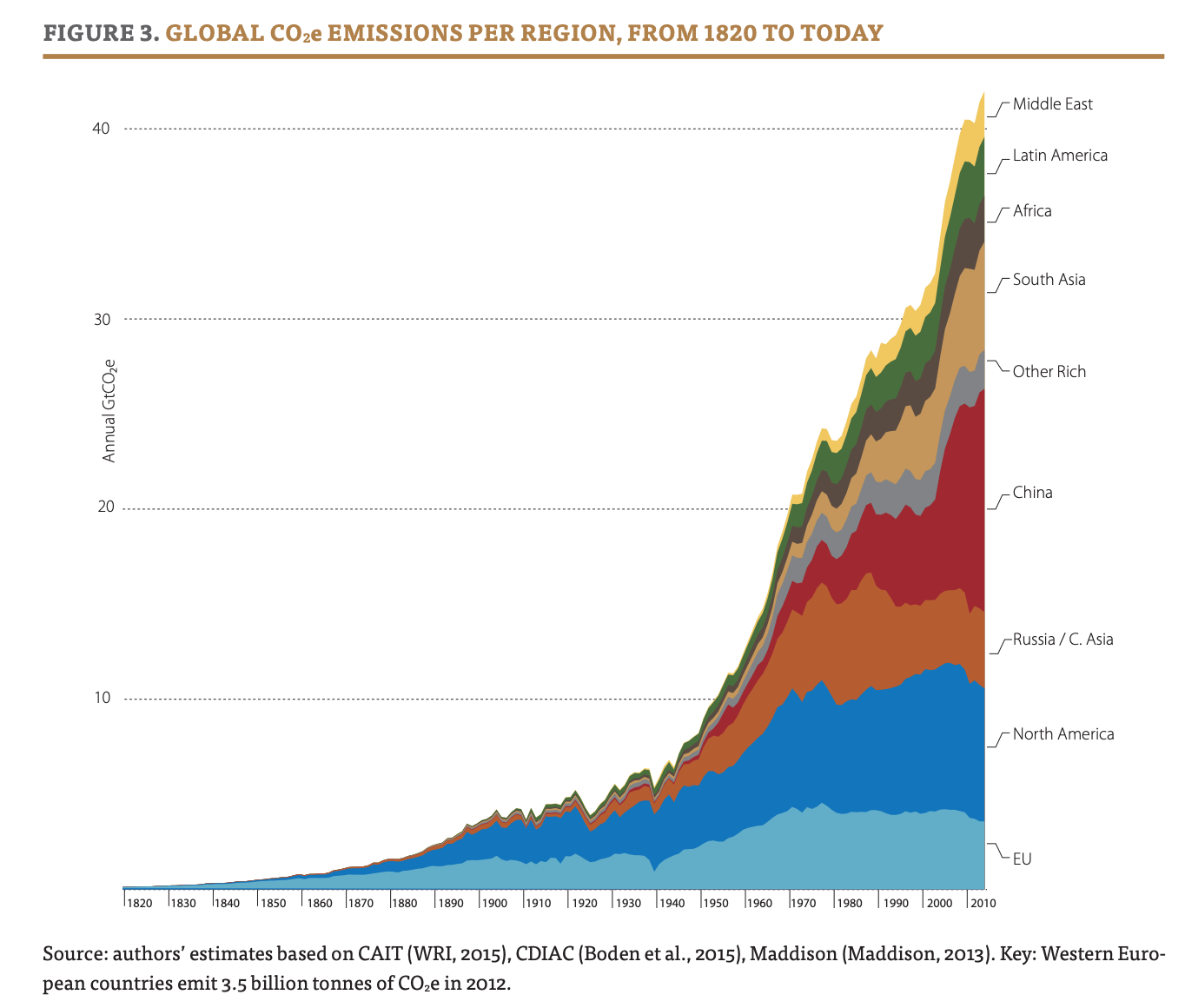
Source: Chancel and Piketty 2015
The result is a pattern of emissions that is still characterized by huge disparities. But these disparities no longer neatly align with national boundaries or the North-South divide. Within a giant country like India, a substantial upper class enjoys Western elite standards of consumption and global mobility, whilst hundreds of millions struggle to get by with limited access to electricity and clean means of cooking.
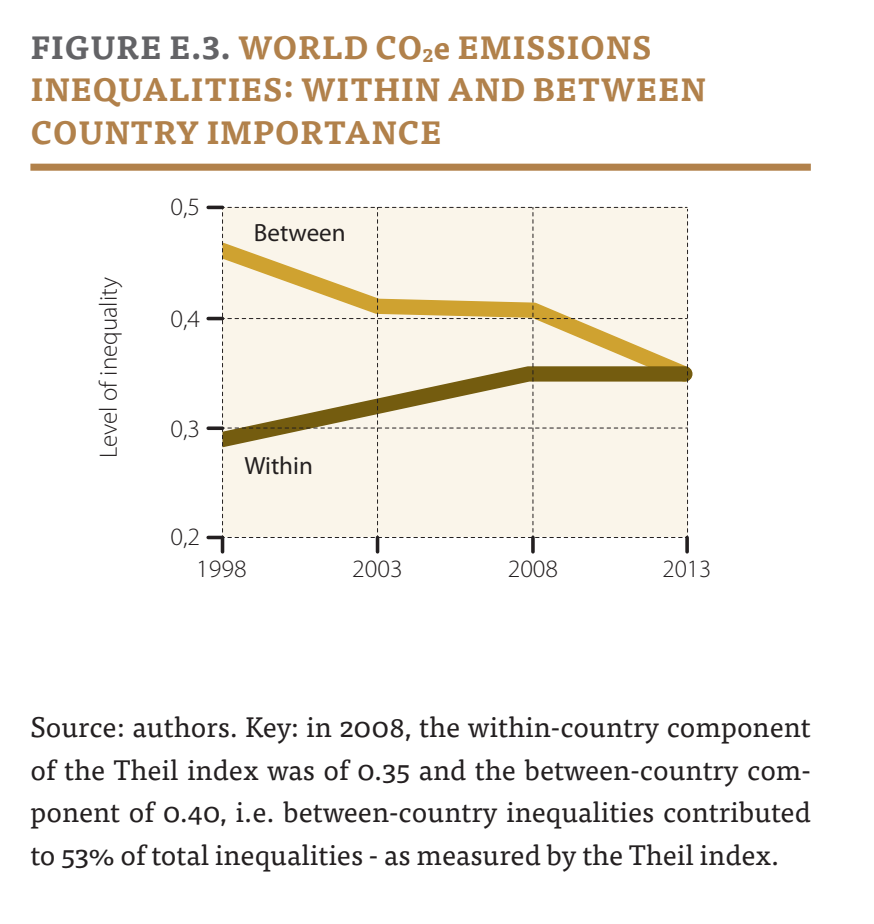
Source: Chancel and Piketty 2015
Not for nothing it was a pioneering report by Greenpeace in India which in 2007 pushed the issue of inequality to the fore. Provocatively entitled “Hiding behind the poor”, it documented the huge disparity in per capita emissions between India’s poor, which were amongst the lowest in the world, and those of the most affluent 10 million Indians, whose consumption was close to the global average and within striking distance of the average for France.

Source: Greenpeace 2007
Unsurprisingly, these provocative findings sparked a lively debate. As one survey remarked: “the inequalities in emissions was only the latest manifestation of longstanding debates over India’s development path.”
In 2015, in time for the Paris climate talks, Thomas Piketty brought the apparatus of global inequality statistics to bear on the emissions problem. Together with Lucas Chancel he published a study. which adopted Branko Milanović’s approach to the global income distribution and mapped it onto CO2 emissions.
Their data chimed with the central agenda of the Paris climate talks. To break the impasse that had prevailed since the Kyoto talks of the 1990s the priority in Paris was to devise a framework in which the large emerging markets made commitments alongside the United States, Europe and Japan. Piketty and Chancel mobilized their data to reinforce this push. Treating all consumers in countries of the “global North” as essentially similar, ignored huge disparities in consumption and emissions.
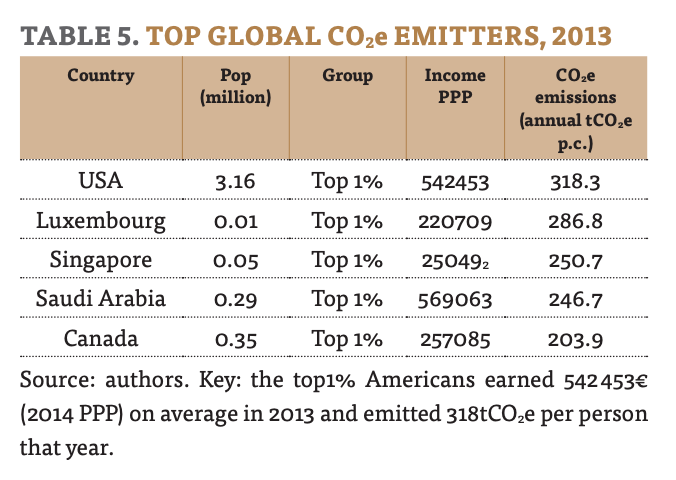
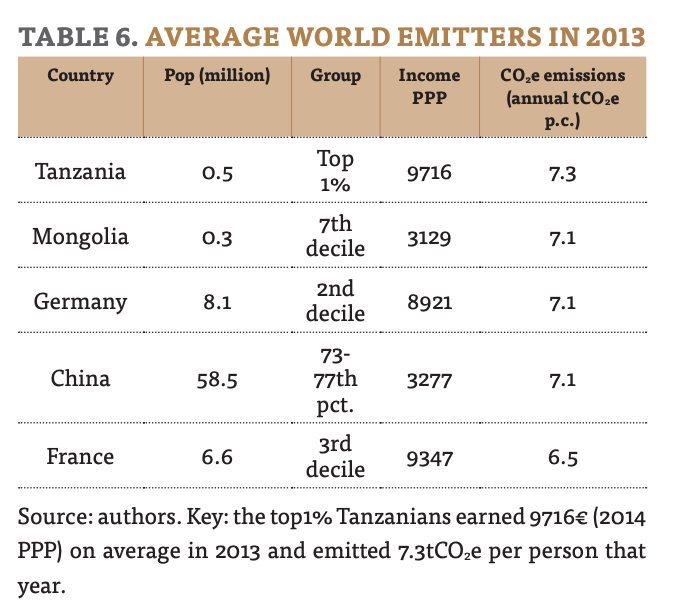
Source: Chancel and Piketty 2015
Why should working-class Europeans, whose emissions were no greater than the global average, be asked to make sacrifices on the same terms as super-consuming Americans or Singaporeans? Why should emerging market millionaires not be called upon to make proportionate reductions? Well ahead of the Gilets Jaunes protests, Chancel and Piketty’s results gave notice that the problem of the just transition could not be ignored. Though European working-class energy consumption was far above that in developing economies, it was far below elite levels in Europe, let alone in the US or the OPEC countries. To address these inequalities they proposed a global levy that could be targeted at those most responsible for the climate crisis, whether judged by income or some other index, such as air miles.
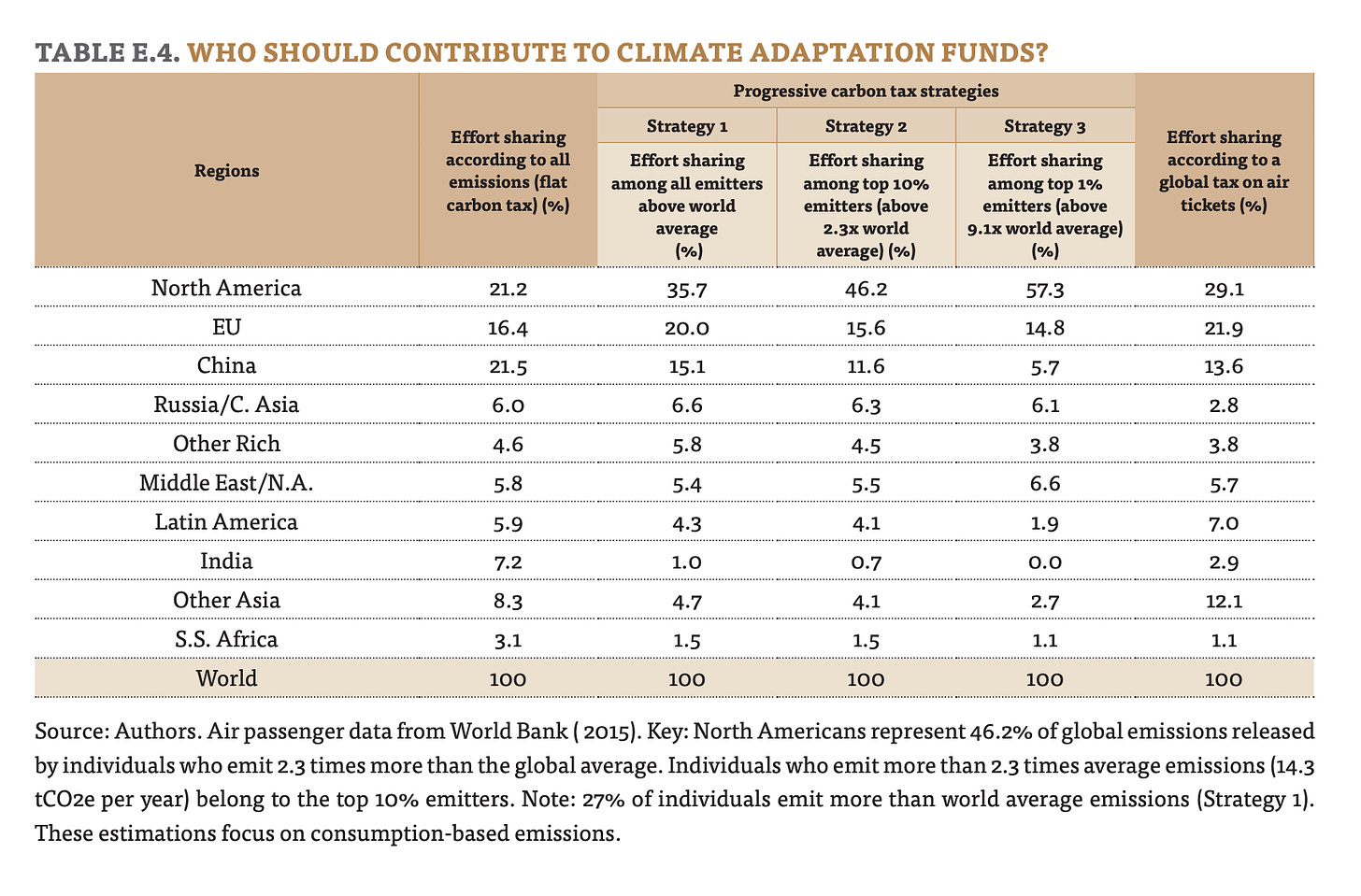
Source: Chancel and Piketty 2015
In 2020 Oxfam and the Stockholm Environment Institute published an updated study of global inequality in emissions. Looking at the change between 1990 and 2015 they demonstrated the existence of what they called a dinosaur curve.
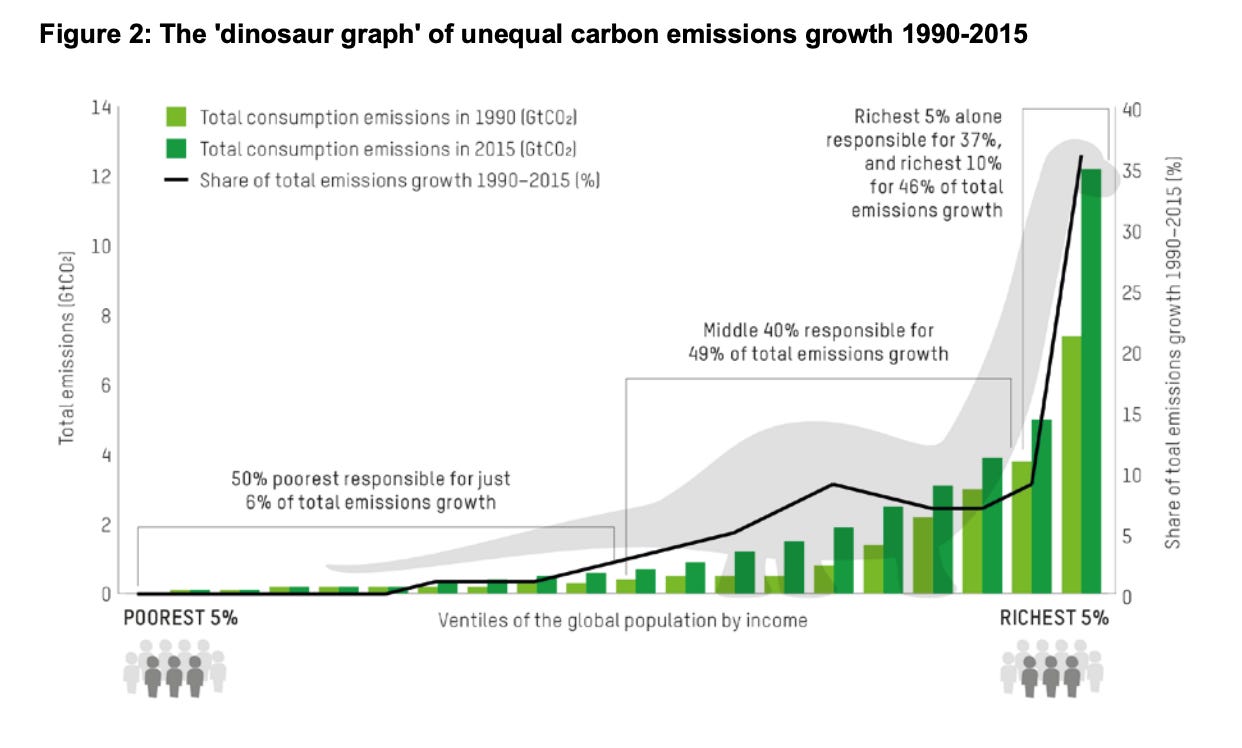
Source: Oxfam 2020
Between 1990 and 2015 emissions rose across the curve of global incomes with a particular bulge around the global middle class, but the really striking feature of the graph is the huge surge in the emissions of the top 10 percent of the global income distribution and within that privileged group the surge in emissions by the top one percent.
As Oxfam emphasizes, the idea that “global population growth” is a significant contributor to the climate crisis is utterly tendentious. Population growth concentrated in sub Saharan Africa and latin America or amongst the poor in Asia has a minimal impact on the global emissions balance. Nor would it make much difference if the bottom billion were to be provided with basic electricity connections, as is demanded by the Sustainable Development Goals. It is the volume of energy consumption that matters and that is dominated by the top half of the income distribution. It is not the development aspirations of the global poor that are driving the climate crisis, but the relentless increase in the already excessive consumption of the more affluent half of the world’s population and particularly that of the top 10 and top 1 percent.

Source: Oxfam/SEI 2020
Just shy of half the increase between 1990 and 2015 is attributable to the top 10 percent, amongst which a large part of the European and North American population are fortunate to count themselves.
A deep dive on consumption patterns in Europe show how high levels of air travel differentiate the most affluent Europeans from those living on more modest incomes.

Source: Oxfam 2020
If Europe wants to make serious inroads on its emissions, it will need to use all available means to curb the frequent flying of its most affluent citizens. Hence the urgency of the call being made both in France and Germany to end short-haul air travel.
But, as is also clear from the Oxfam data, Europe was not the main driver of the surge in global emissions after 1990. Even the most affluent Europeans only increased their emissions by 5 percent over this period. Europe’s growth has been too slow and its level of inequality after tax has not increased sharply enough to make a significant contribution to the global dinosaur curve.
To see where the global growth is coming from, we can combine the Oxfam data for shares of emissions by income group with the data on the share of each country in each income group.

Source: Own calculations based on SEI/Oxfam 2020
The result is striking: Of the increase in global emissions between 1990 and 2015 half is accounted for by China. Two thirds of that is due to the Chinese middle class. One third down to the Chinese top 10 percent. Those are by far the most dynamic elements in the global emissions map. Other hot spots include the top 10 percent of the population in the Middle East and North Africa and the same group in North America. Rising emissions in India and the rest of Asia contribute almost a quarter of the overall growth but growth is spread across the income distribution.
If we ask how far each region contributes to the increase in emissions by each income class, the conclusions are similarly stark. Of the increase in global emissions of 18.9% contributed by those belonging to the top 1% of global incomes, North Americans accounted for 19%, residents of MENA 27% and China 28.2%. The negative numbers in some cells of the table reflect the way in which the growth of the Chinese economy has lifted a large part of its population out of the bottom 50 percent of the global distribution.

Source: Own calculations based on SEI/Oxfam 2020
The conclusion is unavoidable: If there is to be a stabilization of global emissions it will involve a U-turn in the trajectory of consumption, particularly amongst the top ten percent of households in North America, the Arab world and Asia.
This involves new lifestyle choices. But, viewing the problem in terms of individual choices only goes so far. Consumer choices are constrained by the range of goods and services on offer and the type of infrastructure that is installed. A fundamental shift in fossil fuel consumption must be driven by infrastructural decisions.
But rather than simply juxtaposing individual consumption and societal infrastructure decision, we need to ask: who makes infrastructure decisions? Who is it who frames policy options and shapes public opinion, whether in the national media or the social networks? Who is it who legislates? Who governs? Who is it who engineers technical solutions? Who leads businesses, small and large to buy into the trajectory of decarbonization?
From the manager of a national utility to the forward-thinking electrical contractor who decides to propose new solar solutions to his clients, it is, when it comes down to it, the same group highlighted by the consumption data – the folks in the top 10 percent of the income distribution – who drive the development of infrastructure.
Viewed in these terms the distinction between individual consumption choices and the structures that guide and constrain those individual choices, is blurred. Both are the result of action by the same minority. And this entanglement becomes even more compelling when we consider another aspect of the energy transition – the question of financing.
The central economic question of the coming decades is how to mobilize the resources necessary for a major wave of energy investment. Setting aside issues of financial technique, the energy transition will require tens of trillions of dollars in clean energy assets to be added to balance sheets. Most forecasters project that the majority of those assets will ultimately end up on private balance sheets – whether it be in the form of shares in renewable energy utilities, domestic solar arrays, a billion-strong fleet of electric vehicles, or a new generation of low-emission aircraft and cargo ships. That portion which ends up financed through public spending will, in large part, be funded by the issuance of public debt, of which a substantial fraction will ultimately end up on private balance sheets.
What do we know about private balance sheets? Even more than the distribution of income and consumption, the distribution of wealth is skewed towards the top. Insofar as the energy transition is financed through the issuance of financial assets they will be held overwhelmingly by the same 10 percent of households who through their consumption account for a vastly disproportionate share of emissions growth and through their decision-making shape the energy infrastructure of their societies. Furthermore, as a recent IEA study makes clear, this too will be a global affair. If the emerging markets and low-income developing countries are to achieve an energy transition, the majority of that transition will be financed from local sources, on the balance sheets of local wealth holders.
This train of thought is, up to a point, an exercise in tautology. If the pattern of consumption is to change, it is those who consume who have to consume differently. If we are to decide on an energy transition, it is those who decide who have to make the decision. If we are to finance an energy transition, it those who finance things who must provide the finance. These things are by definition true.
Laying out a tautology is not an empty exercise, if it helps to concentrate our attention on the essentials. It is all the more useful, if, as in this case, it leads to the conclusion that the group identified by each of these tautologies is, in fact, the same.
If the analysis of the skewed distribution of consumption, decision-making power, and financial capacity all lead us to the same place, it is not by accident. Where we have arrived is at the analysis of class identities, class relations and class power.
There are, of course, no shortage of analyses that relate the climate crisis to the dynamics of capitalism. A good case can be made that rather than the Anthropocene, we should be discussing the Capitalocene. But apart from being ungainly, that neologism also has the tendency to direct analysis towards the rather abstract concept of “capital”. One of the bracing effects of the kind of sociologic al sketch offered here is that rather than “capitalism” it focuses attention on classes, on groups of people, on us. Few readers of this newsletter will not find themselves in the crosshairs of this analysis.
To say that class analysis is more concrete than the analysis of capital, is not to say that it is simple. If anything the contrary is true. In this essay I have deliberately avoided committing to any particular terminology. One hesitates to use the English term “ruling class”, because its connotations are too restrictive to cover a group as wide as that considered here. The same is true of “elites”, or “technocracy”. One is tempted to borrow from Italian the notion of the “directing class” (classe dirigente). Perhaps, after all, the notion of Bürgertum (the rough German equivalent for bourgeois) in its capacious sense of entitled, enfranchised or propertied classes is the most appropriate.
Whatever our choice of terms, we can hardly avoid the conclusion that if there is to be an energy transition, under prevailing conditions (an assumption some may wish to challenge), it is this social class that must make it, simultaneously as decision-makers, consumers and investors. And it must be made across the entire world. It is a challenge of a kind that the global bourgeoisie has never faced before. It is a challenge that puts in question the cohesion and collective intelligence of that group – which, as history tells us, can hardly be taken for granted, even at the best of times.
